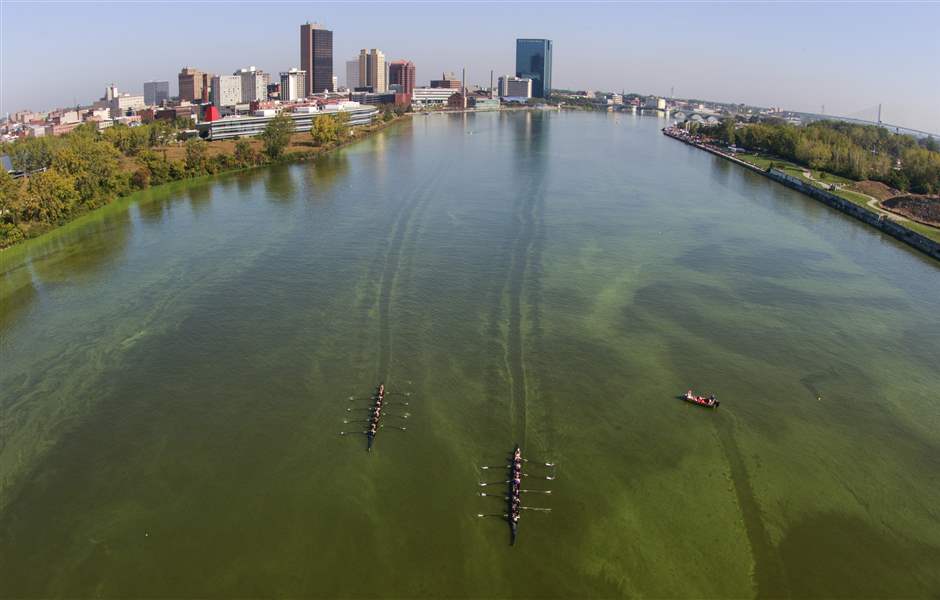
Panel appointed to study health of Lake Erie
8/20/2018
In September the Maumee River took on a greenish hue for the Frogtown Regatta
The Blade
Buy This Image
COLUMBUS — After a state panel at least temporarily shelved Gov. John Kasich’s move to have nearly half of Lake Erie’s western basin watershed declared distressed, legislative leaders have appointed a panel to delve into the pollution problem.
Half of the task force’s 14 members hail from northwest Ohio, including state Rep. Mike Sheehy (D., Oregon), who voiced concern that this is yet one more task force that won’t lead to action.
“That was my concern in the first place, that this was an opportunity for leadership in both houses to take a hot issue and talk about it for a while until public interest goes away,” he said. “We’ll have another bad year with algal blooms in the western basin of Lake Erie, nothing gets done, and the public gets distracted by other things.”
The panel also includes some lawmakers who are farmers or otherwise live far from the watersheds in question.
The panel will be co-chaired by state Sen. Bob Hackett (R., London) and Rep. Brian Hill (R., Zanesville), the chairmen of the agriculture committees in their respective chambers.
Both were highly critical of Mr. Kasich’s move last month to order his administration to ask the independent Ohio Soil and Water Conservation Commission to designate a large chunk of the Maumee River Basin in distress because of the high levels of phosphorous runoff that fuels toxic algal growth.
The designation would have triggered tighter rules on the use of fertilizers by the nearly 7,000 farmers in eight full and partial watersheds that flow into the river and ultimately Lake Erie.
The request won the general support of environmental groups and severe push-back from agriculture.
The panel will meet on Aug. 28 at the Statehouse in Columbus and plans to meet in northwest Ohio sometime this fall.
Members from northwest Ohio include Sens. Randy Gardner (R., Bowling Green), Edna Brown (D., Toledo), and Rob McColley (R., Napoleon), and Reps. Sheehy, Steve Arndt (R., Port Clinton), Jim Hoops (R., Napoleon), and Riordan McClain (R., Upper Sandusky).
Mr. Gardner sees the Toward a Cleaner Lake Erie Working Group as an extension of the recently signed Senate Bill 299, the Clean Lake 2020 Plan that puts $36 million in state funds, including $20 million to directly help farmers, behind efforts to dam the flow of nutrient runoff.
“I want direct input from this group on the most effective ways to spend the $20 million Phosphorus Reduction Fund in the Clean Lake 2020 Plan,” he said. “I want to know if Ohio State Stone Lab needs any additional support on top of the in-lake monitoring and expanded lab space provided in the Clean Lake 2020 Plan.
“These and other issues aren’t study questions,” Mr. Gardner said. “These are questions that can lead to helpful action right now.”
The Soil and Water Conservation Commission last month put off a decision on the governor’s request. It assigned the issue to a subcommittee for further discussion.
The request would have declared the Platter Creek, Little Flat Rock Creek, Little Auglaize River, Eagle Creek, Auglaize River, Blanchard River, St. Marys River, and Ottawa River watersheds or subwatersheds. Together they represent about 40 percent of Ohio’s share of Lake Erie’s western basin.
“With the task force bringing together stakeholders and communities on this issue, opening up to business, Lake Erie residents, and the agricultural industry, we hope it can be productive to keep talking and get concrete solutions to pursue legislatively,” said Peter Bucher, water resources director for the Ohio Environmental Council.
Mr. Kasich has voiced frustration that he couldn’t find a fellow Republican in the legislature willing to introduce legislation to toughen the state’s reaction to agricultural nutrient runoff. The state maintains voluntary efforts to date have not moved the needle in terms of meeting Ohio’s commitment with Michigan and Ontario to reduce phosphorous loading into the lake by 40 percent by 2025.
Farmers, however, have argued that they felt blindsided and targeted by Mr. Kasich’s executive order.
Joe Logan — president of the Ohio Farmers Union whose members tend to skew toward small and moderate-sized, family farms — said he is “not terribly optimistic” something substantive will come from this.
“Scientists tell us there’s a lot of work to do and that it’s mostly agriculture that needs to do the work,” he said. “My sense in meetings with farmers in the northwest Ohio watershed is that, sure, people are worried about regulation. The agricultural community has been habitually opposed to any additional regulatory matters over the course of decades.
“That situation persists, but we collectively have to get over that a little bit and understand that regulation is one of the ways to get members on board and working in a productive direction,” Mr. Logan said.
Contact Jim Provance at jprovance@theblade.com or 614-221-0496.